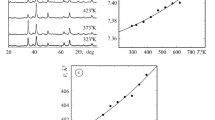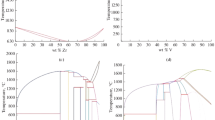Abstract
The aim of this investigation is to establish the effect of relaxation on the formation of ordered substitutional solid solutions in Al1 − x M x alloys (M = 3d metal; x = 1.6 at %). As the main parameters of the process of formation of the aluminum-based solution, thermodynamic quantities such as the energy of dissolution and the cohesive energy have been chosen; for choosing the most appropriate substitutional element, an analysis of the relaxation energy and deviations of empirical atomic radii of the impurity from the radius of the matrix-forming element has been suggested. It has been shown that there is a correlation between these thermodynamic quantities through the behavior of the density of electronic states and the Fermi energy. A regular relation has also been demonstrated to exist between the relaxation and stability of arising solid solutions, which supports the applicability of the analysis of relaxation energy depending on the atomic radius of the matrix-substituting element. The presence of anomalies in the behavior of magnetic properties of some aluminum alloys with transition metals has been shown and their explanation is given.
Similar content being viewed by others
References
I. M. Razumovskii, A. V. Ruban, V. I. Razumovskiy, A. V. Logunov, V. N. Larionov, O. G. Ospennikova, V. A. Poklad, and B. Johanson, “New Generation of Ni-Based Superalloys Designed on the Basis of First-Principles Calculations,” Mater. Sci. Eng., A 497, 18–24 (2008).
L. Vitos, Computational Quantum Mechanics for Materials Engineers. The EMTO Methods and Applications (Springer Verlag, London, 2007).
A. V. Ruban and H. L. Skriver, “Screened Coulomb Interactions in Metallic Alloys. I. Universal Screening in the Atomic-Sphere Approximation,” Phys. Rev. B: Condens. Matter Mater. Phys. 66, 024201 (2002).
A. V. Ruban, S. I. Simak, P. A., Korzhavyi, and H. L. Skriver, “Screened Coulomb Interactions in Metallic Alloys. II. Screening beyond the Single-Site and Atomic-Sphere Approximations,” Phys. Rev. B: Condens. Matter Mater. Phys. 66, 024202 (2002).
T. Hoshino, M. Asato, R. Zeller, and P. H. Dederichas, “Full-Potential KKR Calculations for Vacancies in Al: Screening Effect and Many-Body Interactions,” Phys. Rev. B: Condens. Matter Mater. Phys. 70, 094118 (2004).
E. Šimanek and S. Yoksan, “Anomalous Specific Heat and Nuclear Spin Relaxation in Al-Transition Metal Alloys,” Phys. Lett., A 70, 122–124 (1979).
C. J. Smithells, Metals Reference Book (Butterworths, London, 1967; Metallurgiya, Moscow, 1980).
N. Papanikolau, R. Zeller, P. H. Dederichs, and N. Stefanou, “Lattice Distortion in Cu-Based Dilute Alloys: A First-Principles Study by the KKR Green-Function Method,” Phys. Rev. B: Condens. Matter 55, 4157–4167 (1997).
R. Benedek, L. H. Yang, C. Woodward, and B. I. Min, “Formation Energy and Lattice Relaxation for Point Defects in Li and Al,” Phys. Rev. B: Condens. Matter 45, 2607 (1992).
A. de Vita and M. J. Gillant, “The Ab Initio Calculation of Defect Energetics in Aluminium,” J. Phys.: Condens. Matter 3, 6225–6237 (1991).
D. Guenzburger and D. E. Ellis, “Fe Impurity in Al: Magnetic or Nonmagnetic?” Phys. Rev. Lett. 67(27), 3832–3835 (1991).
D. Guenzburger and D. E. Ellis, “Lattice-Distortion Effects on the Magnetism of Mn Impurities in Al and Cu,” Phys. Rev. B: Condens. Matter 49, 6004–6011 (1994).
D. Bagayoko, L. Puiman, N. Brener, and J. Callaway, “3d Transition-Metal Impurities in Aluminum,” Phys. Rev. B: Condens. Matter 54(17), 12184–12193 (1996).
T. Hoshino, M. Asato, S. Tanaka, F. Nakamura, and N. Fujima, “First-Principles Calculations for Stability of Atomic Structures of Al-Rich AlX (X = Sc-Zn) Alloys, Including AlMn Quasicrystal: II. Medium-Ranged Interactions of X Pairs in Al,” Intermetallics 14(8–9), 913–916 (2006).
T. Hoshino, N. Fujima, M. Asato and R. Tamura “Medium-Ranged Interactions of Transition-Metal (3d and 4d) Impurity Pairs in Al and Atomic Structures of Al-Rich Al-Transition-Metal Alloys,” J. Alloys Compd., 434–435, 572–576 (2007).
W. Kohn, “Nobel Lecture: Electronic Structure of Matter—Wave Functions and Density Functionals,” Rev. Mod. Phys., 71, 1253–1266 (1999).
P. Hohenberg and W. Kohn, “Inhomogeneous Electron Gas,” Phys. Rev. B, 136, 864–847 (1964).
W. Kohn and L. J. Sham, “Self-Consistent Equations Including Exchange and Correlation Effects,” Phys. Rev. B. 140, 1133–1138 (1965).
P. E. Blöchl, “Projector Augmented-Wave Method,” Phys. Rev. B: Condens. Matter 50, 17953–17979 (1994).
G. Kress and D. Joubert, “From Ultrasoft Pseudopotentials to the Projector Augmented-Wave Method,” Phys. Rev. B: Condens. Matter Mater. Phys. 59, 1758–1775 (1999).
G. Kress and J. Hafner, “Ab Initio Molecular Dynamics for Liquid Metals,” Phys. Rev. B: Condens. Matter 47, 558–561 (1993).
G. Kress and J. Hafner, “Ab Initio Molecular-Dynamics Simulation of the Liquid-Metal-Amorphous-Semiconductor Transition in Germanium,” Phys. Rev. B: Condens. Matter 49, 8522–8525 (1994).
G. Kress and J. Furthmuller, “Efficiency of Ab-Initio Total Energy Calculations for Metals and Semiconductors Using a Plane-Wave Basis Set,” Comput. Mater. Sci. 6, 15–50 (1996).
G. Kress and J. Furthmuller, “Efficient Iterative Schemes for Ab Initio Total-Energy Calculations Using a Plane-Wave Basis Set,” Phys. Rev. B: Condens. Matter 54, 11169–11186 (1996).
J. P. Perdew, J. A. Chevary, S. H. Vosko, K. A. Jackson, M. R. Pederson, D. J. Singh, and C. Fiolhais, “Atoms, Molecules, Solids, and Surfaces: Applications of the Generalized Gradient Approximation for Exchange and Correlation,” Phys. Rev. B: Condens. Matter 46, 6671–6687 (1992).
J. P. Perdew, J. A. Chevary, S. H. Vosko, K. A. Jackson, M. R. Pederson, D. J. Singh, and C. Fiolhais, “Erratum: Atoms, Molecules, Solids, and Surfaces: Applications of the Generalized Gradient Approximation for Exchange and Correlation,” Phys. Rev. B: Condens. Matter 48, 4978 (1993).
J. P. Perdew and A. Zunger, “Self-Interaction Correction to Density-Functional Approximations for Many-Electron Systems,” Phys. Rev. B: Condens. Matter 23, 5048–5079 (1981).
H. J. Monkhorst and J. D. Pack, “Special Points for Brillouin-Zone Integrations,” Phys. Rev. B: Solid State 13, 5188–5192 (1972).
A. V. Ruban and H. L. Skriver, “Ab Initio Calculations of Partial Molar Properties in the Single-Site Approximation,” Phys. Rev. B: Condens. Matter 55, 8801–8807 (1997).
Ch. Kittel, Introduction to Solid State Physics (Wiley, New York, 1975; Nauka, Moscow, 1978).
M. S. Brooks and B. Johansson, “Exchange Integral Matrices and Cohesive Energies of Transition Metal Atoms,” J. Phys. F: Met. Phys. 13, L197–L202 (1983).
J. C. Slater, “Atomic Radii in Crystals,” J. Chem. Phys. 41, 3199–3205 (1964).
Ya. S. Umanskii and Yu. A. Skakov, Fizika metallov (Metal Physics) (Atomizdat, Moscow, 1978) [in Russian].
D. G. Pettifor, Bonding and Structure of Molecules and Solids (Clarendon Press, Oxford, 1995).
V. M. Cherkashenko, S. Z. Nazarova, A. I. Gusev, and A. L. Ivanovskii, “Electron Structure, Chemical Bonding, and Properties of Binary M-{x} M′-{y} C-{z} Carbides in Crystalline and Molecular State Studied by X-ray Emission Electron Spectroscopy and Quantum Chemistry,” Zh. Strukt. Khim. 42, 1195–1221 (2001).
Author information
Authors and Affiliations
Additional information
Original Russian Text © N.Yu. Nikitin, 2012, published in Fizika Metallov i Metallovedenie, 2012, Vol. 113, No. 5, pp. 451–462.
Rights and permissions
About this article
Cite this article
Nikitin, N.Y. A first-principles investigation of the effect of relaxation on the alloy formation in the aluminum-3d-transition-metal system. Phys. Metals Metallogr. 113, 427–437 (2012). https://doi.org/10.1134/S0031918X12050043
Received:
Accepted:
Published:
Issue Date:
DOI: https://doi.org/10.1134/S0031918X12050043




